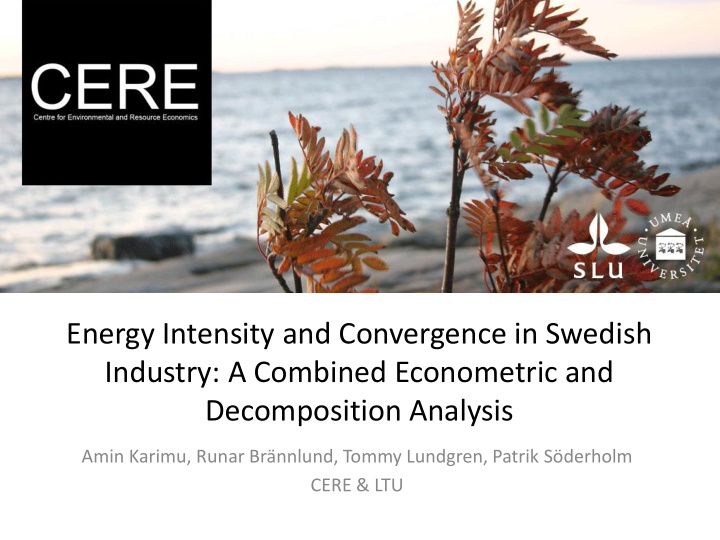



Energy Intensity and Convergence in Swedish Industry: A Combined Econometric and Decomposition Analysis Amin Karimu, Runar Brännlund, Tommy Lundgren, Patrik Söderholm CERE & LTU
Outline • Motivation • Model • Results • Conclusion
Motivation • Environmental problems and energy concerns calls for a clearer understanding on the link between energy and output. • Investments in new energy efficient technologies will play a role in understanding this link and the industrial sector is a major player. • Important to have a clear understanding of the drivers of energy intensity in industry sectors. • Especially the extend to which changes in industrial energy intensity is driven by structural shifts and/or from efficiency improvements. • The need to provide evidence on potential knowledge transfer between leading and lagging sectors in terms of energy intensity. • The objectives of this study is to provide – (1) evidence on the determinants of energy intensity and – (2) understanding of differences in cross -sector energy intensity dynamics; is there convergence in energy intensity?
Model • The empirical model is based on production theory, sort of. • We assume that each sector produces output by combining capital, labor and energy inputs. • Based on this production relationship we derive the associated cost function. • Further, we derive the input demand functions, especially that of energy to obtain the energy intensity model, basically by dividing the energy demand by output. • Energy intensity is decomposed into an efficiency term and an activity term
Model • Energy intensity can be decomposed into activity and efficiency (Metcalf, 2008). Fischer ideal index type. = S(it) is ~ sector activity L = Laspeyres, anchored in initial period P = Paasche, anchored in current period
Model • Two models were estimated • An energy intensity determinants model. • An energy intensity convergence model. - m and g are twice differentialble and can handle continous and discrete vars - (t-3) used to reduce cyclical effects
Data • 14 manufacturing industry sectors in Sweden for the period 1990 to 2008. • The Energy variables comprises of both quantities and prices for fossil fuels, electricity, biofuel and district heating. • The economic variables include output, wages, user/rental price of capital. • Productivity ( A ) is assumed to be determined by environmental R&D cost (-) and capacity utilization (-), the latter a variable derived as the potential output over actual output. Potential output created using the Hodrick- Prescott filter (Bernstein, 2003). • 3 indexes derived: 1) Energy intensity index, 2) efficiency index and 3) activity index.
Data
Results
Results Changes in energy intensity Seems to stem from the efficiency component mainly
Results
Results Convergence stems from the Activity or output component mainly
Conclusions • Input prices are significantly associated with energy intensity. • Higher prices of energy tend to trigger an increase in energy efficiency. • Both capacity utilization and R&D are not associated with energy intensity. • The input price effect is mainly from the efficiency channel. • We find evidence to support energy intensity convergence. • The convergence is from the activity or output channel.
Conclusions • Factor input mixes played significant roles as drivers of energy intensity in Swedish industry. • The channel of each of the price effects on energy intensity primarily stemmed from the efficiency channel. • Swedish industry shifted away from more to less energy-intensive production. • Even though not explicitly analyzed in this paper, the relatively ambitious Swedish energy policies, such as the active use of energy and carbon taxes, increase in renewable and nuclear energy, probably affected the dynamics of energy intensity improvements significantly.
Recommend
More recommend